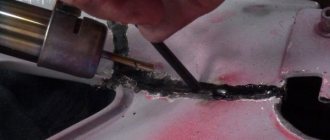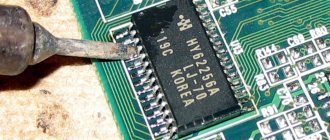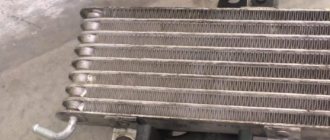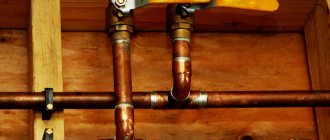On modern cars, the bumper has long ceased to perform its original function of protecting the body or frame from damage. Now it is a decorative plastic element, which itself suffers from minor accidents and requires large repair costs.
If you purchase a cheap product from budget manufacturers, you may encounter problems with the geometry and appearance of the car. However, there is a way out in the form of repairing the factory part, especially if all the debris has been preserved and the damage is not catastrophic.
Requirements for tools for soldering plastic
Each tool used during work ensures the implementation of one of the basic components of the repair. It can be fundamentally different in design and principle of operation, but at the same time serve the same purpose:
- heating, the main thing that is required when working with thermoplastic plastics, with its help you can both give the desired shape to a part and be embedded in its structure using a filler or reinforcing material;
- cleaning and preparation for painting, the repaired surface must be carefully leveled and create the desired roughness;
- reinforcement, such as gluing, welding or soldering, will not be able to provide the specified strength.
Various tools can be used for heating:
- an ordinary soldering iron of sufficient power, it is very desirable to be able to adjust the temperature;
- an industrial hair dryer differs from a household hair dryer in the very high temperature of the blown air, which can reach up to 600 degrees and above, the energy is also regulated;
- a gas burner has high thermal power, but works with an open fire, which is not always desirable;
- a specialized device for reinforced soldering of plastic - a heated stapler, it uses wire staples of various shapes, heated by the low-voltage winding of a transformer to the melting temperature of the plastic, very similar to the “Moment” type pulse soldering irons known to many.
Further processing can be carried out using drill attachments with adjustable rotation speed.
Types of plastics
In order to successfully repair a car element, it is worth determining in advance what kind of plastic it is made of. All plastics can be divided into hard and soft. In particular, fiberglass plastics that do not have any markings are considered soft.
Hard types of plastics can have different markings, for example, ABS, GF30, PAG6. The markings are visible if you look from the back of the vehicle part. Polypropylene (PP marking) is considered the most durable.
Quite often, vehicle owners require soldering of ABS plastic, since it is from this material that the bumpers of cars of many well-known brands are made.
How to prepare a plastic bumper for restoration
First of all, you need to collect all the fragments and fold the bumper along the cracks. This will make sure that the repair will be reduced only to fixing debris and cracked parts, and there will be no need to prepare patches.
All parts are thoroughly washed, dried and degreased. Any contamination will reduce the strength of the seams.
On topic: How to repair a crack in a plastic bumper yourself
Depending on the chosen technology, cleaning, chamfering, and selection of additives may be required. It is important to know the material from which the bumper is made; the melting point and the possibility of using heating in principle depend on this.
For example, fiberglass parts do not melt and will require adhesive compounds and repair kits.
The edges of the parts are securely fixed with clamping devices such as clamps or welding pliers.
Use of a soldering iron
Let's assume that the plastic bumper of a car is seriously damaged and needs to be repaired by soldering. How to do it?
To make it easier to solder the structure, it must be removed from the car. It also doesn’t hurt to look at the labeling in advance. Most likely, the part will be made of ABS plastic.
Then you should clean the surface of the bumper from dirt, remove paint and varnish residues. Additionally, the entire plastic part must be degreased. Next, you need to connect all the fragments of the bumper together.
For such a connection, it is important to use clamps or staples. But this must be done carefully so that they do not penetrate through the car plastic.
Soldering plastic with a standard soldering iron should begin from the inside of the car bumper . To do this, one of its edges is securely fixed, and special plastic electrodes are laid along the future seam (although the name “electrodes” in this case is very arbitrary).
At the next stage, a soldering iron for soldering plastic melts the electrode material, and it fills all the recesses of the crack. This operation must be repeated as many times as stitches need to be made, that is, it all depends on the initial number of defects and damage.
Now you need to wait for the molten mass (characteristic bubbles appear on it) to cool a little - this will take about five minutes. Then you need to smooth out the seams on the plastic.
In principle, any blunt object can be used for this procedure. In hard-to-reach places, the surface can be smoothed and leveled with gloved hands. Complete hardening of the seams will occur in a few hours. At this point, the soldering of the auto plastic can be considered complete.
How to solder a bumper using a soldering iron
Polypropylene, polyethylene and polyurethane bumpers can be soldered with a conventional electric soldering iron with a power of about 100 Watts. The tip must be clean and free of metal solder residues.
The material from the edges of the crack is moved by the tip of the heated tip into the middle, forming short stitches. After which the crack is filled and leveled. To strengthen the seam, metal brackets or reinforcing mesh are fused into it, which is preheated with a hairdryer or torch.
It is pressed into the bumper material with a heated soldering iron, recessed completely, and the plastic is smoothed out.
After cooling, the finished seam is sanded and puttied using a special polyester or epoxy putty, which should be designed specifically for working on plastic, since it will require elasticity and good adhesion.
The filler material can be taken from the same bumper, which has areas that do not perform any functions and are not externally noticeable. This will ensure full compatibility of the plastic.
Reinforcing mesh
Also, home craftsmen can use in their work such a device as a reinforcing mesh for soldering hard plastic.
It is needed to ensure that the final result is stronger and more durable. This mesh is placed on the inside of the structures.
Then, using a soldering iron or hair dryer, it is heated and, in this state, pressed into the plastic using a screwdriver. The mesh should become a kind of frame that holds and strengthens the part.
Excess plastic resulting from reinforcement can be removed using a grinding machine or an ordinary knife. If you work carefully on the outside, traces of cracks and breaks will not be visible even close up.
Soldering with a hot air gun
Sealing cracks with an industrial hair dryer is similar to welding with an acetylene torch.
The hair dryer usually comes with nozzles; it is better to choose the minimum one that provides a directed flow of hot air into a hole with a diameter of several millimeters. Otherwise, the bumper may move due to heating of undamaged areas.
For soldering, you must use filler material from the same part. The edges of the crack are heated until melting, after which plastic solder is applied there.
Metal brackets are used for reinforcement. The temperature is selected after testing, overheating is unacceptable, the plastic will bubble and burn, such a seam is fragile and weak.
How to weld a bumper with a rod
The filler rod will act as both a filler and a reinforcing agent. It is heated with a hairdryer and placed in the crack area, usually in the form of a triangular zigzag, after which it is pressed along the crack.
This is interesting: Is it necessary to install a mesh in the bumper to protect the radiator?
To avoid excess, the edges of the cracks are processed with a drill, forming chamfers. The resulting weld pools are filled with a plastic rod. For fusing, the temperatures of the edges and the rod are approximately equalized by a flow of hot air.
Using a hair dryer
Soldering automotive plastic is done a little differently if a heat gun (hair dryer) is used. Here you will need special welding rods (essentially, this is solder for soldering plastic).
You can purchase them in specialized stores or even make them yourself. The main thing is that they are similar to the material being welded. One of the ends of the rod is sharpened and then inserted into the corresponding hole in the nozzle of the heat gun.
The hair dryer should be moved slowly along the crack being repaired; the filler rod should be inclined towards the workpiece at an angle of approximately 45°. If a plastic part has shattered into separate pieces, then soldering it with a hairdryer is carried out in two passes.
First, the pieces or fragments are fastened together with short stitches (seams). And only after this the final reliable soldering is made. When the material has cooled, the surface of the part is puttied and sanded, preparing for painting.
To repair the plastic of a motorcycle, all kinds of elements of its external design, you can use soldering using approximately the same technology as in the case of repairing a car bumper. Moreover, motorcycle panels are usually made of the same ABS plastic.
How to glue a bumper with composite material
Some parts are made of heat-stable plastic, which cannot be heated. In this case, repair kits made of epoxy or polyester resin with fiberglass for reinforcement are used. The technology of work here is fundamentally different.
The edges of the cracks are cut with a drill, sanded with coarse sandpaper to roughen it, after which the first layer of resin is applied.
From the inside, a layer of fiberglass is applied to the crack and smoothed, overlapping it by several centimeters. A second layer of resin is applied on top, which will provide a reliable “sandwich” with reinforcement.
The combination of fabric and compound practically restores the original structure of the fiberglass part, which allows not only to bridge cracks, but also to eliminate large defects, such as lost fragments.
The protruding layers are located from the inside of the part, and possible depressions from the outside are filled with elastic putty on plastic. It can be of different types, depending on the filler. Coarse compositions provide the strength of thick layers, and finishing ones provide surface quality for grinding and priming.
Painting a repaired part is quite complicated; painting the metal of the body is easier. Special materials and a complex color selection process will be required. It is better to entrust such work to professionals or be prepared for trial and error.
Tips and life hacks for soldering a bumper
The tips below will help you properly repair a crack or hole in the bumper. Thanks to them, you can achieve high seam strength and durability.
- When choosing how to solder a bumper on a car with your own hands, consider the melting point of the material.
The lower it is, the more accurate the adjustment of the heating of the tool must be so as not to damage the part. For example, ABS can be soldered with almost any hair dryer, and polyurethane can only be soldered with a stable temperature of about 200 degrees. To prevent overheating, it is better to first set the temperature below the operating temperature, and then increase it gradually. Reinforcing a bumper crack with copper wire - As a reinforcing material, use mesh or brackets made of corrosion-resistant metal. The best option is stainless steel, copper or brass.
- Cracks with smooth edges that close tightly and do not reach the edge of the part can be soldered without an additive. The melted plastic will give a fairly strong seam.
- To repair polypropylene bumpers, you can use homemade filler tapes, cut from lockers (fender liners) using metal scissors. For other materials, fragments of similar bumpers that can be found at auto dismantling yards are suitable.
- If you want to do without dismantling the part, you need to carefully remove the chamfers on the crack, since it will not be possible to solder the bumper without removing it. This option is suitable for polypropylene bumpers, which are easily soldered without reinforcement.
- Focus on strength rather than beauty, and leave a raised area in the seam area, since it is possible to solder a bumper without painting only if it is originally unpainted polypropylene or polyurethane. Other materials will still have to be puttied and painted after repair, after leveling the surface.
When painting the bumper yourself after soldering, be sure to consider the type of plastic and use the appropriate primer. If the technology is not followed, the bumper will quickly peel off. It is best to give the bumper to professionals for painting, since without a spray-drying chamber and a spray gun, high-quality painting of the part is impossible.











